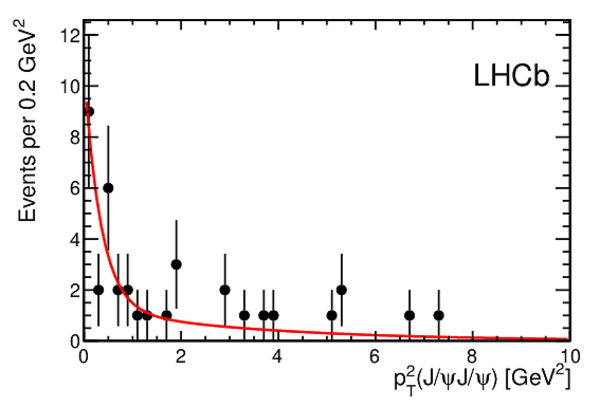Information
LHCb-PAPER-2014-027
CERN-PH-EP-2014-174
arXiv:1407.5973 [PDF]
(Submitted on 22 Jul 2014)
J. Phys. G41 (2014) 115002
Inspire 1307250
Tools
Abstract
A search is performed for the central exclusive production of pairs of charmonia produced in proton-proton collisions. Using data corresponding to an integrated luminosity of $3{\rm\ fb}^{-1}$ collected at centre-of-mass energies of 7 and 8 TeV, $J/\psi J/\psi$ and $J/\psi\psi(2S)$ pairs are observed, which have been produced in the absence of any other activity inside the LHCb acceptance that is sensitive to charged particles in the pseudorapidity ranges $(-3.5,-1.5)$ and $(1.5,5.0)$. Searches are also performed for pairs of P-wave charmonia and limits are set on their production. The cross-sections for these processes, where the dimeson system has a rapidity between 2.0 and 4.5, are measured to be $$ \begin{array}{rl} \sigma^{J/\psi J/\psi} &= 58\pm10{(\rm stat)} \pm 6{(\rm syst)} {\rm\ pb} , \\ \sigma^{J/\psi\psi(2S)} &= 63 ^{+27}_{-18}{(\rm stat)}\pm 10{(\rm syst)} {\rm\ pb} , \\ \sigma^{\psi(2S)\psi(2S)} &< 237 {\rm\ pb}, \\ \sigma^{\chi_{c0}\chi_{c0}} &< 69 {\rm\ nb}, \\ \sigma^{\chi_{c1}\chi_{c1}} &< 45 {\rm\ pb}, \\ \sigma^{\chi_{c2}\chi_{c2}} &< 141 {\rm\ pb}, \\ \end{array} $$ where the upper limits are set at the 90 confidence level. The measured $J/\psi J/\psi$ and $J/\psi\psi(2S)$ cross-sections are consistent with theoretical expectations.
Figures and captions
|
Representative Feynman diagrams for pairs of charmonia produced through double pomeron exchange. In the left, one $t$-channel gluon is much softer than the other while in the right, they are similar. |
Fig1a.pdf [33 KiB] HiDef png [52 KiB] Thumbnail [28 KiB] *.C file |

|
|
Fig1b.pdf [33 KiB] HiDef png [53 KiB] Thumbnail [31 KiB] *.C file |

|
|
|
Left: Invariant masses of pairs of oppositely charged muons in events with exactly four tracks. Of the two possible ways of combining the muons per event, the one with the higher value for the lower-mass pair is plotted. Right: Invariant mass of the second pair of tracks where the first pair has a mass consistent with the $ { J \mskip -3mu/\mskip -2mu\psi \mskip 2mu}$ or $\psi {(2S)}$ meson. When both masses are consistent with a charmonium, only the candidate with the higher mass is displayed. The curve shows an exponential fit in the region below 2500 $\mathrm{ Me V}$ . |
Fig2a.pdf [13 KiB] HiDef png [114 KiB] Thumbnail [72 KiB] *.C file |

|
|
Fig2b.pdf [15 KiB] HiDef png [112 KiB] Thumbnail [111 KiB] *.C file |

|
|
|
Invariant mass of the four-muon system in (left) $ { J \mskip -3mu/\mskip -2mu\psi \mskip 2mu} { J \mskip -3mu/\mskip -2mu\psi \mskip 2mu} $ and (right) $ { J \mskip -3mu/\mskip -2mu\psi \mskip 2mu} \psi {(2S)} $ events. |
Fig3a.pdf [13 KiB] HiDef png [65 KiB] Thumbnail [36 KiB] *.C file |

|
|
Fig3b.pdf [13 KiB] HiDef png [65 KiB] Thumbnail [31 KiB] *.C file |

|
|
|
Number of tracks passing the $ { J \mskip -3mu/\mskip -2mu\psi \mskip 2mu} { J \mskip -3mu/\mskip -2mu\psi \mskip 2mu} $ exclusive selection after having removed the requirement that there be no additional charged tracks or photons. The shaded histogram is the expected feed-down from exclusive $ { J \mskip -3mu/\mskip -2mu\psi \mskip 2mu} \psi {(2S)} $ events. |
Fig4.pdf [14 KiB] HiDef png [96 KiB] Thumbnail [108 KiB] *.C file |

|
|
Transverse momentum squared distribution of candidates for exclusively produced (left) $ { J \mskip -3mu/\mskip -2mu\psi \mskip 2mu} { J \mskip -3mu/\mskip -2mu\psi \mskip 2mu} $ and (right) dimuons whose invariant mass is between 6 and 9 $\mathrm{ Ge V}$ . The curves are fits to the data as described in the text. |
Fig5a.pdf [14 KiB] HiDef png [120 KiB] Thumbnail [110 KiB] *.C file |

|
|
Fig5b.pdf [16 KiB] HiDef png [123 KiB] Thumbnail [126 KiB] *.C file |

|
|
|
Animated gif made out of all figures. |
PAPER-2014-027.gif Thumbnail |

|
Tables and captions
|
Summary of numbers entering the cross-section calculation. |
Table_1.pdf [59 KiB] HiDef png [63 KiB] Thumbnail [27 KiB] tex code |

|
|
Percentage uncertainties on the quantities entering the denominator of Eq. (2). |
Table_2.pdf [54 KiB] HiDef png [41 KiB] Thumbnail [18 KiB] tex code |

|
Supplementary Material [file]
| Supplementary material full pdf |
supple[..].pdf [60 KiB] |

|
|
Fig6.pdf [14 KiB] HiDef png [124 KiB] Thumbnail [115 KiB] *C file |

|
Created on 27 April 2024.
